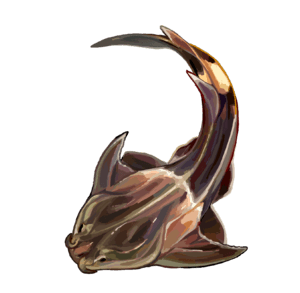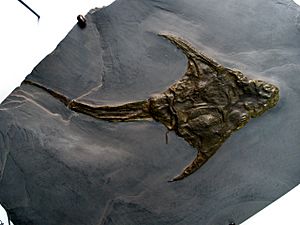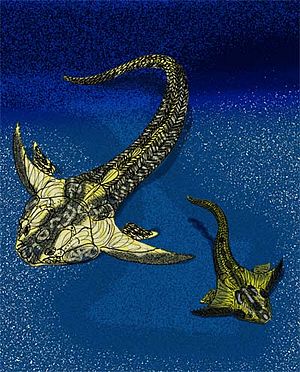Lunaspis facts for kids
Quick facts for kids LunaspisTemporal range: Emsian
|
|
|---|---|
 |
|
| Artist's reconstruction of L. heroldi | |
| Scientific classification | |
| Kingdom: | |
| Phylum: | |
| Class: | |
| Order: |
Petalichthyida
|
| Family: |
Macropetalichthyidae
|
| Genus: |
Lunaspis
|
| Species: |
L. heroldi
|
| Type species | |
| Lunaspis heroldi Broili 1929
|
|
| species | |
|
|
| Synonyms | |
|
|
Lunaspis was an extinct type of fish that lived a very long time ago. It was a kind of placoderm, which means it had armor plates. These fish lived in shallow ocean waters during the Early Devonian period. This was about 409.1 to 402.5 million years ago.
Scientists have found Lunaspis fossils in Germany, China, and Australia. There are three known types, or species, of Lunaspis: L. broilii, L. heroldi, and L. prumiensis.
Like many other fish from its group, Lunaspis had a flat body. It had long, pointy fins near its head and a short body armor. Its eyes looked upwards. Lunaspis also had a long, thin tail that looked a bit like a whip. This made it similar to modern skates and rays.
Contents
What Lunaspis Looked Like
Lunaspis was a flat fish with a short body. It had long, curved plates that stuck out from its head. These plates looked like a crescent moon, which is why it was named Lunaspis. "Luna" means moon, and "aspis" means shield.
The front part of its head, near its nose and eyes, was covered in tiny scales. Its long body was also covered in these small scales.
Lunaspis lived on the seafloor, just like many other armored fish from the Devonian period. It was a nektonic carnivore, meaning it swam and hunted other animals. Its body was flattened from top to bottom. This shape helped it live on the ocean floor.
Lunaspis had a short body shield and long, wing-like plates. These plates formed the moon shape around its head. The parts of its body not covered by large armor plates had tiny scales. Lunaspis also had some features that were very old, or "primitive," for its group. These included large plates under its edges and a small pit on its main back plate.
Its Bony Armor
Scientists have studied Lunaspis fossils from Australia. They found that both L. broilii and L. heroldi had small bumps on their main back plate. These bumps joined together to form a clear ridge down the middle. This joined ridge is special to Lunaspis among its fish group. Other fish in this group had separate bumps.
The ridge was highest before the back edge of the main plate. The wing-like plates were curved and had many small spines along their front edge. The patterns on these bony plates help scientists tell Lunaspis apart from other armored fish. These patterns were widely spaced and continuous across all three Lunaspis species. In L. broilii, the patterns were closer together than in L. heroldi and L. prumiensis.
How Lunaspis Was Discovered
The name Lunaspis comes from two Greek words. "Luna" means "The Moon," and "aspis" means "Round Shield." So, Lunaspis means "moon shield." This name fits well because the long parts of its head shield look like a crescent moon.
The first L. broilii fossils were found and described by two German scientists, Walter R. Gross and Ferdinand Broili. Broili first found L. heroldi in Germany in 1929. Then, in 1937, he found another fossil in Germany that looked like Lunaspis heroldi. At first, he thought it was the same species. But he noticed some differences in its shape.
Around the same time, another scientist named Gross was studying a Lunaspis fossil. He thought it was Lunaspis prumiensis. Gross was working with small pieces of the head bones of this unknown Lunaspis. The two scientists soon met and compared their fossils. They worked together to find the differences between the known species.
Based on the bones from the spine and lower front part of the body, they realized their new fossil was different. It was a new species within the same group as L. heroldi and L. prumiensis. They named this new species Lunaspis broilii. L. broilii is usually larger than L. heroldi.
At first, L. broilii fossils were only found in Germany. But in 1980, a scientist named Liu Shifan found more fossils in China that were likely L. broilii. More recently, L. broilii fossils have been found in New Zealand. These are very similar to those found in Australia. They all have the same bumpy patterns typical of Lunaspis. L. heroldi fossils have also been found in similar old ocean rocks in China and Australia.
How Lunaspis Is Classified
Lunaspis was first placed in a group called Acanthaspidae. But in 1937, Walter R. Gross found that the main fish in that group, Acanthaspis, was actually the same as Lunaspis. So, the whole Acanthaspidae group was combined into the Macropetalichthyidae family.
Today, Lunaspis is grouped with seven other fish in the Macropetalichthyidae family. It is also related to two other families within the Petalichthyida group.
Where Lunaspis Lived
Fossils from New Zealand were found in a place called the Waitahu Outlier. This area is made of silty mudstone and calcareous siltstone, which are types of rock formed in the ocean. The rocks where Lunaspis was found are about 407.6 to 393.3 million years old.
Scientists found many other fossils with Lunaspis at this site. These included brachiopods (shellfish), bivalves (like clams), orthocene nautiloids (ancient squid-like creatures), bryozoans (tiny colonial animals), and parts of crinoids (sea lilies). This tells us that Lunaspis lived in a busy ocean environment with many other sea creatures.
See also
 In Spanish: Lunaspis para niños
In Spanish: Lunaspis para niños



